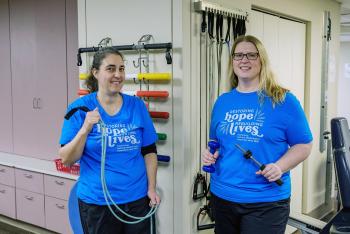School nurse Tamisha Nicole Jones shares her courageous journey of overcoming multiple brain...
Read MoreEffective Monday, January 5th, Inspira Health is now at Yellow Alert Status: Masks for staff, patients and visitors in all high-risk areas across our facilities are strongly recommended.

Back pain is common and affects millions worldwide. Whether it's lower back pain, upper back pain or the pain, weakness, numbness or tingling in the leg known as sciatica, targeted exercises can play a vital role in relieving discomfort and improving overall back health.
Poor posture, muscle strain, abnormal pelvic tilt (anterior tilt), which misaligns the hips, and herniated discs, where the cushion between spine bones slips, are common causes of lower back pain. Depending on your condition, an orthopedic specialist may recommend stretching and strengthening exercises to alleviate lower back pain.
“For individuals with lower back pain, stretching and strengthening exercises can help improve flexibility and reduce pain,” said Ragone.
Upper back pain often stems from poor posture, stress or muscle tension. Incorporating exercises that target your upper back and shoulders can help alleviate pain and improve posture.
Sciatica is a painful condition, often caused by sciatic nerve compression or irritation. Pressure on the nerve results in pain radiating down the leg. Stretching and strengthening exercises can provide relief and improve mobility.
Incorporating these targeted exercise routines into your daily regimen can help alleviate various types of back pain, promoting a healthier back and an improved quality of life. Always consult an orthopedic specialist, health care professional, or physical therapist before starting any exercise routine, especially if you have pre-existing medical conditions or concerns.
Ready to take control of your back pain and get back to enjoying life? Schedule an appointment with an orthopedic specialist today! Our team of experts can help you develop a personalized plan for a stronger, healthier back.
Call us at 1-800-INSPIRA or schedule your appointment today!

School nurse Tamisha Nicole Jones shares her courageous journey of overcoming multiple brain...
Read More
Physical rehabilitation focuses on making steady progress by using personalized care plans and a...
Read More
Continuing rehabilitation at home with a personalized recovery plan not only tailors exercises to...
Read More